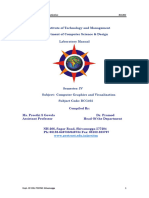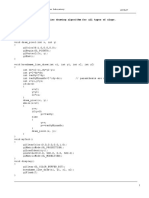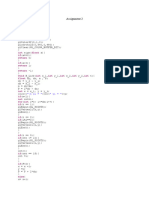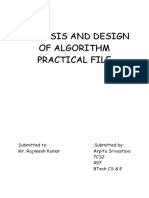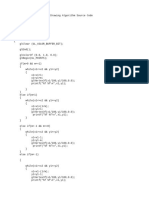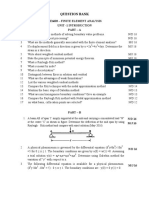Lab Program - 1: Implement Bresenham's Line Drawing Algorithm For All Types of Slope
Lab Program - 1: Implement Bresenham's Line Drawing Algorithm For All Types of Slope
Uploaded by
pavanCopyright:
Available Formats
Lab Program - 1: Implement Bresenham's Line Drawing Algorithm For All Types of Slope
Lab Program - 1: Implement Bresenham's Line Drawing Algorithm For All Types of Slope
Uploaded by
pavanOriginal Description:
Original Title
Copyright
Available Formats
Share this document
Did you find this document useful?
Is this content inappropriate?
Copyright:
Available Formats
Lab Program - 1: Implement Bresenham's Line Drawing Algorithm For All Types of Slope
Lab Program - 1: Implement Bresenham's Line Drawing Algorithm For All Types of Slope
Uploaded by
pavanCopyright:
Available Formats
Maharaja Institute of Technology Mysore Department of Computer Science & Engineering
Lab Program - 1
Implement Bresenham’s line drawing algorithm for all types of slope.
#include<windows.h>
#include<GL/glu.h>
#include<GL/glut.h>
#include<math.h>
void Draw()
{
GLfloat x1=450,y1=350,x2=150,y2=350;
GLfloat M,p,dx,dy,x,y,t;
glClear(GL_COLOR_BUFFER_BIT);
if((x2-x1)==0)
M = (y2-y1);
else
M = (y2-y1)/(x2-x1);
if(fabs(M)<1)
{
if(x1>x2)
{
t = x1;
x1 = x2;
x2 = t;
t = y1;
y1 = y2;
y2 = t;
}
dx = fabs(x2-x1);
dy = fabs(y2-y1);
p = 2*dy-dx;
x=x1;
y=y1;
glBegin(GL_POINTS);
while(x<=x2)
{
glVertex2f(x,y);
x=x+1;
if(p>=0)
{
if(M<1)
y=y+1;
else
y=y-1;
p = p+2*dy-2*dx;
}
else
{
y=y;
p = p+2*dy;
Prof. Santosh E, Asst. Prof., Dept. of CS&E, MIT Mysore Page | 1
Maharaja Institute of Technology Mysore Department of Computer Science & Engineering
}
}
glEnd();
}
if(fabs(M)>=1)
{
if(y1>y2)
{
t = x1;
x1 = x2;
x2 = t;
t = y1;
y1 = y2;
y2 = t;
}
dx = fabs(x2-x1);
dy = fabs(y2-y1);
p = 2*dx-dy;
x=x1;
y=y1;
glBegin(GL_POINTS);
while(y<=y2)
{
glVertex2f(x,y);
y=y+1;
if(p>=0)
{
if(M>=1)
x=x+1;
else
x=x-1;
p = p+2*dx-2*dy;
}
else
{
x=x;
p = p+2*dx;
}
}
glEnd();
}
glFlush();
}
void MyInit()
{
glMatrixMode(GL_PROJECTION);
glLoadIdentity();
gluOrtho2D(0,500,0,500);
glMatrixMode(GL_MODELVIEW);
}
Prof. Santosh E, Asst. Prof., Dept. of CS&E, MIT Mysore Page | 2
Maharaja Institute of Technology Mysore Department of Computer Science & Engineering
int main(int argC,char *argV[])
{
glutInit(&argC,argV);
glutInitDisplayMode(GLUT_RGB|GLUT_SINGLE);
glutInitWindowPosition(0,0);
glutInitWindowSize(500,500);
glutCreateWindow("Brenham’s Line Drawing Algo");
MyInit();
glutDisplayFunc(Draw);
glutMainLoop();
return 0;
}
https://youtu.be/H1RtMA3XV3k
Design a Flow Chart or Write the Algorithm (Need to do it yourself)
Prof. Santosh E, Asst. Prof., Dept. of CS&E, MIT Mysore Page | 3
Maharaja Institute of Technology Mysore Department of Computer Science & Engineering
Lab Program - 2
Create and rotate a triangle about the origin and a fixed point.
#include<windows.h>
#include<GL/glu.h>
#include<GL/glut.h>
GLfloat R,px,py;
void Draw()
{
glClear(GL_COLOR_BUFFER_BIT);
glColor3f(0,0,1);
glBegin(GL_LINE_LOOP);
glVertex2f(0.1,0.4);
glVertex2f(0.7,0.4);
glVertex2f(0.4,0.8);
glEnd();
glLoadIdentity();
glTranslatef(px,py,0);
glRotatef(R,0,0,1);
glTranslatef(-px,-py,0);
glColor3f(1,0,0);
glBegin(GL_LINE_LOOP);
glVertex2f(0.1,0.4);
glVertex2f(0.7,0.4);
glVertex2f(0.4,0.8);
glEnd();
glFlush();
}
int main(int argC,char *argV[])
{
printf("Enter the Rotation Reference Point [Pivot Point] : ");
scanf("%f%f",&px,&py);
printf("Enter the Rotation Degree : ");
scanf("%f",&R);
glutInit(&argC,argV);
glutInitDisplayMode(GLUT_RGB|GLUT_SINGLE);
glutInitWindowPosition(0,0);
glutInitWindowSize(500,500);
glutCreateWindow("Triangle Rotation");
glutDisplayFunc(Draw);
glutMainLoop();
return 0;
}
https://youtu.be/apF4MUgp6k8
Prof. Santosh E, Asst. Prof., Dept. of CS&E, MIT Mysore Page | 4
Maharaja Institute of Technology Mysore Department of Computer Science & Engineering
Design a Flow Chart or Write the Algorithm (Need to do it yourself)
Prof. Santosh E, Asst. Prof., Dept. of CS&E, MIT Mysore Page | 5
Maharaja Institute of Technology Mysore Department of Computer Science & Engineering
Lab Program - 3
Draw a colour cube and spin it using OpenGL transformation matrices.
#include<windows.h>
#include<GL/glu.h>
#include<GL/glut.h>
GLfloat d = 0;
int a=0;
void MyInit()
{
glClearColor(0,0,0,1);
glEnable(GL_DEPTH_TEST);
}
void Spin()
{
d = d + 0.25;
if(d > 360)
d = 0;
glutPostRedisplay();
}
void Face(GLfloat A[],GLfloat B[],GLfloat C[],GLfloat D[])
{
glBegin(GL_POLYGON);
glVertex3fv(A);
glVertex3fv(B);
glVertex3fv(C);
glVertex3fv(D);
glEnd();
}
void Cube(GLfloat V0[],GLfloat V1[],GLfloat V2[],GLfloat V3[],GLfloat V4[],GLfloat V5[],GLfloat
V6[],GLfloat V7[])
{
glColor3f(1,0,0);
Face(V0,V1,V2,V3); //Front
glColor3f(0,1,0);
Face(V4,V5,V6,V7); //Back
glColor3f(0,0,1);
Face(V0,V4,V7,V3); //Left
glColor3f(1,1,0);
Face(V1,V5,V6,V2); //Right
glColor3f(1,0,1);
Face(V2,V3,V7,V6); //Bot
glColor3f(0,1,1);
Face(V0,V1,V5,V4); //Top
}
void Draw()
{
GLfloat V[8][3] = {
{-0.5, 0.5, 0.5},
{ 0.5, 0.5, 0.5},
{ 0.5,-0.5, 0.5},
{-0.5,-0.5, 0.5},
Prof. Santosh E, Asst. Prof., Dept. of CS&E, MIT Mysore Page | 6
Maharaja Institute of Technology Mysore Department of Computer Science & Engineering
{-0.5, 0.5,-0.5},
{ 0.5, 0.5,-0.5},
{ 0.5,-0.5,-0.5},
{-0.5,-0.5,-0.5},
};
GLfloat rV[8][3],r;
int i;
glClear(GL_COLOR_BUFFER_BIT | GL_DEPTH_BUFFER_BIT);
r = d*3.14/180;
if(a == 1)
{
for(i=0;i<8;i++)
{
rV[i][0] = V[i][0];
rV[i][1] = V[i][1]*cos(r)-V[i][2]*sin(r);
rV[i][2] = V[i][1]*sin(r)+V[i][2]*cos(r);
}
}
if(a == 2)
{
for(i=0;i<8;i++)
{
rV[i][0] = V[i][2]*sin(r)+V[i][0]*cos(r);
rV[i][1] = V[i][1];
rV[i][2] = V[i][2]*cos(r)-V[i][0]*sin(r);
}
}
if(a == 3)
{
for(i=0;i<8;i++)
{
rV[i][0] = V[i][0]*cos(r)-V[i][1]*sin(r);
rV[i][1] = V[i][0]*sin(r)+V[i][1]*cos(r);
rV[i][2] = V[i][2];
}
}
Cube(rV[0],rV[1],rV[2],rV[3],rV[4],rV[5],rV[6],rV[7]);
glutSwapBuffers();
}
int main(int argc, char *argv[])
{
printf("Enter the Axis of Rotation [ 1->Xaxis | 2->Yaxis | 3->Zaxis ]: ");
scanf("%d",&a);
glutInit(&argc,argv);
glutInitWindowSize(600,600);
glutInitWindowPosition(50,150);
glutInitDisplayMode(GLUT_RGB | GLUT_DOUBLE | GLUT_DEPTH);
glutCreateWindow("Cube Spin with Matrices");
MyInit();
glutDisplayFunc(Draw);
glutIdleFunc(Spin);
glutMainLoop();
return 0;
Prof. Santosh E, Asst. Prof., Dept. of CS&E, MIT Mysore Page | 7
Maharaja Institute of Technology Mysore Department of Computer Science & Engineering
https://youtu.be/YKX2Np7omJQ
Design a Flow Chart or Write the Algorithm (Need to do it yourself)
Prof. Santosh E, Asst. Prof., Dept. of CS&E, MIT Mysore Page | 8
Maharaja Institute of Technology Mysore Department of Computer Science & Engineering
Lab Program - 4
Draw a color cube and allow the user to move the camera suitably to experiment
with perspective viewing.
#include<windows.h>
#include<GL/glu.h>
#include<GL/glut.h>
GLfloat Cx=0,Cy=0,Cz=3;
void MyInit()
{
glClearColor(0,0,0,1);
glEnable(GL_DEPTH_TEST);
glMatrixMode(GL_PROJECTION);
glLoadIdentity();
glFrustum(-1,1,-1,1,2,10);
glMatrixMode(GL_MODELVIEW);
}
void Square(GLfloat A[],GLfloat B[],GLfloat C[],GLfloat D[])
{
glBegin(GL_POLYGON);
glVertex3fv(A);
glVertex3fv(B);
glVertex3fv(C);
glVertex3fv(D);
glEnd();
}
void Cube(GLfloat V0[],GLfloat V1[],GLfloat V2[],GLfloat V3[],GLfloat V4[],GLfloat V5[],GLfloat
V6[],GLfloat V7[])
{
glColor3f(1,0,0);
Square(V0,V1,V2,V3);
glColor3f(0,1,0);
Square(V4,V5,V6,V7);
glColor3f(0,0,1);
Square(V0,V4,V7,V3);
glColor3f(1,1,0);
Square(V1,V5,V6,V2);
glColor3f(1,0,1);
Square(V3,V2,V6,V7);
glColor3f(0,1,1);
Square(V0,V1,V5,V4);
}
void Draw()
{
GLfloat V[8][3] = {
{-0.5, 0.5, 0.5},
{ 0.5, 0.5, 0.5},
{ 0.5,-0.5, 0.5},
{-0.5,-0.5, 0.5},
{-0.5, 0.5,-0.5},
{ 0.5, 0.5,-0.5},
{ 0.5,-0.5,-0.5},
{-0.5,-0.5,-0.5}
Prof. Santosh E, Asst. Prof., Dept. of CS&E, MIT Mysore Page | 9
Maharaja Institute of Technology Mysore Department of Computer Science & Engineering
};
glClear(GL_COLOR_BUFFER_BIT | GL_DEPTH_BUFFER_BIT);
glLoadIdentity();
gluLookAt(Cx,Cy,Cz,0,0,0,0,1,0);
Cube(V[0],V[1],V[2],V[3],V[4],V[5],V[6],V[7]);
glutSwapBuffers();
}
void Key(unsigned char ch,int x,int y)
{
switch(ch)
{
case 'x' : Cx = Cx - 0.5; break;
case 'X' : Cx = Cx + 0.5; break;
case 'y' : Cy = Cy - 0.5; break;
case 'Y' : Cy = Cy + 0.5; break;
case 'z' : Cz = Cz - 0.5; break;
case 'Z' : Cz = Cz + 0.5; break;
}
glutPostRedisplay();
}
int main(int argC,char *argV[])
{
glutInit(&argC,argV);
glutInitWindowSize(600,600);
glutInitWindowPosition(100,150);
glutInitDisplayMode(GLUT_RGB | GLUT_DOUBLE | GLUT_DEPTH);
glutCreateWindow("Color Cube with Camera");
MyInit();
glutDisplayFunc(Draw);
glutKeyboardFunc(Key);
glutMainLoop();
return 0;
}
https://youtu.be/elw1WOziruk
Design a Flow Chart or Write the Algorithm (Need to do it yourself)
Prof. Santosh E, Asst. Prof., Dept. of CS&E, MIT Mysore Page | 10
Maharaja Institute of Technology Mysore Department of Computer Science & Engineering
Moving Camera towards Left, Moving Camera towards Left,
Moving Camera far away
Bottom & Away direction Top & Near direction
Prof. Santosh E, Asst. Prof., Dept. of CS&E, MIT Mysore Page | 11
Maharaja Institute of Technology Mysore Department of Computer Science & Engineering
Lab Program - 5
Clip a Line using Cohen-Sutherland Algorithm.
#include<windows.h>
#include<GL/glu.h>
#include<GL/glut.h>
GLfloat xMin=-0.5,xMax=0.5,yMin=-0.5,yMax=0.5;
GLfloat x1=-0.4,y1=-0.3,x2=0.2,y2=0.4;
int Left=1,Right=2,Bot=4,Top=8;
int C1,C2;
int Clip_Flag = 0, Flag = 1;;
int Get_Code(GLfloat x,GLfloat y)
{
int Code = 0;
if(x<xMin)
Code = Code | Left;
if(x>xMax)
Code = Code | Right;
if(y<yMin)
Code = Code | Bot;
if(y>yMax)
Code = Code | Top;
return Code;
}
void Clip()
{
int C;
GLfloat x,y;
if(C1)
C = C1;
else
C = C2;
if(C & Left)
{
x = xMin;
y = y1+(y2-y1)*((xMin-x1)/(x2-x1));
}
if(C & Right)
{
x = xMax;
y = y1+(y2-y1)*((xMax-x1)/(x2-x1));
}
if(C & Bot)
{
y = yMin;
x = x1+(x2-x1)*((yMin-y1)/(y2-y1));
}
if(C & Top)
{
y = yMax;
x = x1+(x2-x1)*((yMax-y1)/(y2-y1));
}
Prof. Santosh E, Asst. Prof., Dept. of CS&E, MIT Mysore Page | 12
Maharaja Institute of Technology Mysore Department of Computer Science & Engineering
if(C == C1)
{
x1 = x;
y1 = y;
}
else
{
x2 = x;
y2 = y;
}
}
void Draw()
{
glClear(GL_COLOR_BUFFER_BIT);
glColor3f(1,1,1);
glBegin(GL_LINE_LOOP);
glVertex2f(xMin,yMin);
glVertex2f(xMax,yMin);
glVertex2f(xMax,yMax);
glVertex2f(xMin,yMax);
glEnd();
glColor3f(1,0,0);
if(Flag == 1)
{
glBegin(GL_LINES);
glVertex2f(x1,y1);
glVertex2f(x2,y2);
glEnd();
}
while(1 & Clip_Flag == 1)
{
C1 = Get_Code(x1,y1);
C2 = Get_Code(x2,y2);
if((C1|C2) == 0)
break;
else if((C1&C2)!=0)
{
Flag = 0;
break;
}
else
Clip();
}
glFlush();
}
void Key(unsigned char ch,int x,int y)
{
Clip_Flag = 1;
glutPostRedisplay();
}
int main(int argC,char *argV[])
{
Prof. Santosh E, Asst. Prof., Dept. of CS&E, MIT Mysore Page | 13
Maharaja Institute of Technology Mysore Department of Computer Science & Engineering
glutInit(&argC,argV);
glutInitWindowSize(500,500);
glutInitWindowPosition(100,100);
glutInitDisplayMode(GLUT_RGB | GLUT_SINGLE);
glutCreateWindow("Cohen-Sutherland Algorithm");
glutDisplayFunc(Draw);
glutKeyboardFunc(Key);
glutMainLoop();
return 0;
}
https://youtu.be/ZeTk3O416QM
Design a Flow Chart or Write the Algorithm (Need to do it yourself)
Before Clipping After Clipping
Prof. Santosh E, Asst. Prof., Dept. of CS&E, MIT Mysore Page | 14
Maharaja Institute of Technology Mysore Department of Computer Science & Engineering
Lab Program - 6
To draw a simple shaded scene consisting of a tea pot on a table. Define suitably
the position and properties of the light source along with the properties of the
surfaces of the solid object used in the scene.
#include<windows.h>
#include<GL/glu.h>
#include<GL/glut.h>
GLfloat T = 0;
void Spin()
{
T = T + 0.1;
if(T>360)
T = 0;
glutPostRedisplay();
}
void Draw()
{
GLfloat Pos[] = {0,1,0,1};
GLfloat Col[] = {1,0,0,1};
GLfloat M[] = {0,1,0,1};
glClear(GL_COLOR_BUFFER_BIT | GL_DEPTH_BUFFER_BIT);
glLoadIdentity();
glLightfv(GL_LIGHT0,GL_POSITION,Pos);
glLightfv(GL_LIGHT0,GL_DIFFUSE,Col);
gluLookAt(0,1,3,0,0,0,0,1,0);
glRotatef(T,0,1,0);
glPushMatrix();
glScalef(1,0.05,1);
glutSolidCube(1);
glPopMatrix();
glPushMatrix();
glTranslatef(-0.5,-0.5,-0.5);
glScalef(0.05,1,0.05);
glutSolidCube(1);
glPopMatrix();
glPushMatrix();
glTranslatef(0.5,-0.5,-0.5);
glScalef(0.05,1,0.05);
glutSolidCube(1);
glPopMatrix();
glPushMatrix();
glTranslatef(0.5,-0.5,0.5);
glScalef(0.05,1,0.05);
glutSolidCube(1);
glPopMatrix();
Prof. Santosh E, Asst. Prof., Dept. of CS&E, MIT Mysore Page | 15
Maharaja Institute of Technology Mysore Department of Computer Science & Engineering
glPushMatrix();
glTranslatef(-0.5,-0.5,0.5);
glScalef(0.05,1,0.05);
glutSolidCube(1);
glPopMatrix();
glPushAttrib(GL_ALL_ATTRIB_BITS);
glMaterialfv(GL_FRONT_AND_BACK,GL_AMBIENT,M);
glPushMatrix();
glTranslatef(0,0.25,0);
glutSolidTeapot(0.25);
glPopMatrix();
glPopAttrib();
glutSwapBuffers();
}
void MyInit()
{
glEnable(GL_DEPTH_TEST);
glMatrixMode(GL_PROJECTION);
glLoadIdentity();
glFrustum(-1,1,-1,1,2,10);
glMatrixMode(GL_MODELVIEW);
glEnable(GL_LIGHTING);
glEnable(GL_LIGHT0);
}
int main(int argC,char *argV[])
{
glutInit(&argC,argV);
glutInitWindowSize(600,600);
glutInitWindowPosition(100,100);
glutInitDisplayMode(GLUT_RGB | GLUT_DOUBLE | GLUT_DEPTH);
glutCreateWindow("Table & TeaPot");
MyInit();
glutDisplayFunc(Draw);
glutIdleFunc(Spin);
glutMainLoop();
return 0;
}
https://youtu.be/RzCOInR4ooc
Design a Flow Chart or Write the Algorithm (Need to do it yourself)
Prof. Santosh E, Asst. Prof., Dept. of CS&E, MIT Mysore Page | 16
Maharaja Institute of Technology Mysore Department of Computer Science & Engineering
Prof. Santosh E, Asst. Prof., Dept. of CS&E, MIT Mysore Page | 17
Maharaja Institute of Technology Mysore Department of Computer Science & Engineering
Lab Program - 7
Design, develop and implement recursively subdivide a tetrahedron to form 3D
sierpinski gasket. The number of recursive steps is to be specified by the user.
#include<windows.h>
#include<GL/glu.h>
#include<GL/glut.h>
int N;
void Triangle(GLfloat A[],GLfloat B[],GLfloat C[])
{
glBegin(GL_TRIANGLES);
glVertex3fv(A);
glVertex3fv(B);
glVertex3fv(C);
glEnd();
}
void Tetra(GLfloat V1[],GLfloat V2[],GLfloat V3[],GLfloat V4[])
{
glColor3f(1,1,1);
Triangle(V1,V2,V3);
glColor3f(1,0,0);
Triangle(V1,V3,V4);
glColor3f(0,1,0);
Triangle(V2,V3,V4);
glColor3f(0,0,1);
Triangle(V1,V2,V4);
}
void Div(GLfloat V1[],GLfloat V2[],GLfloat V3[],GLfloat V4[],int n)
{
GLfloat V12[3],V23[3],V31[3],V14[3],V24[3],V34[3];
if(n>0)
{
V12[0] = ( V1[0] + V2[0] ) / 2; V12[1] = ( V1[1] + V2[1] ) / 2; V12[2] = ( V1[2] + V2[2] ) / 2;
V23[0] = ( V2[0] + V3[0] ) / 2; V23[1] = ( V2[1] + V3[1] ) / 2; V23[2] = ( V2[2] + V3[2] ) / 2;
V31[0] = ( V3[0] + V1[0] ) / 2; V31[1] = ( V3[1] + V1[1] ) / 2; V31[2] = ( V3[2] + V1[2] ) / 2;
V14[0] = ( V1[0] + V4[0] ) / 2; V14[1] = ( V1[1] + V4[1] ) / 2; V14[2] = ( V1[2] + V4[2] ) / 2;
V24[0] = ( V2[0] + V4[0] ) / 2; V24[1] = ( V2[1] + V4[1] ) / 2; V24[2] = ( V2[2] + V4[2] ) / 2;
V34[0] = ( V3[0] + V4[0] ) / 2; V34[1] = ( V3[1] + V4[1] ) / 2; V34[2] = ( V3[2] + V4[2] ) / 2;
Div(V1,V12,V31,V14,n-1);
Div(V12,V2,V23,V24,n-1);
Div(V31,V23,V3,V34,n-1);
Div(V14,V24,V34,V4,n-1);
}
else
Tetra(V1,V2,V3,V4);
}
void Draw()
{
GLfloat P[4][3] = {
{-0.65,-0.5, 0.5},
{ 0.65,-0.5, 0.5},
{ 0 , 0.6, 0.5},
{ 0 ,-0.05,-0.5},
Prof. Santosh E, Asst. Prof., Dept. of CS&E, MIT Mysore Page | 18
Maharaja Institute of Technology Mysore Department of Computer Science & Engineering
};
glClear(GL_COLOR_BUFFER_BIT | GL_DEPTH_BUFFER_BIT);
Div(P[0],P[1],P[2],P[3],N);
glutSwapBuffers();
}
int main(int argC,char *argV[])
{
printf("Enter the Number of Division Steps : ");
scanf("%d",&N);
glutInit(&argC,argV);
glutInitWindowSize(600,600);
glutInitWindowPosition(100,100);
glutInitDisplayMode(GLUT_RGB | GLUT_DOUBLE | GLUT_DEPTH);
glutCreateWindow("3D Sierpinski Gasket");
glutDisplayFunc(Draw);
glutMainLoop();
return 0;
}
https://youtu.be/H1RtMA3XV3k
Design a Flow Chart or Write the Algorithm (Need to do it yourself)
0 Division Step 1 Division Step 2 Division Step
Prof. Santosh E, Asst. Prof., Dept. of CS&E, MIT Mysore Page | 19
Maharaja Institute of Technology Mysore Department of Computer Science & Engineering
Lab Program - 8
Develop a menu driven program to animate a flag using Bezier Curve algorithm.
#include<windows.h>
#include<GL/glu.h>
#include<GL/glut.h>
GLfloat ya = 50,xa = 10;
int yFlag = 1, xFlag = 1,AniFlag=1;
void Animate()
{
if(AniFlag == 1)
{
if(ya>-50 && yFlag == 1)
ya = ya - 0.2;
if(ya<=-50 && yFlag == 1)
yFlag = 0;
if(ya<50 && yFlag == 0)
ya = ya + 0.2;
if(ya>=50 && yFlag == 0)
yFlag = 1;
if(xa>-10 && xFlag == 1)
xa = xa - 0.2;
if(xa<=-10 && xFlag == 1)
xFlag = 0;
if(xa<10 && xFlag == 0)
xa = xa + 0.2;
if(xa>=10 && xFlag == 0)
xFlag = 1;
}
glutPostRedisplay();
}
void Draw()
{
GLfloat x[4],y1[4],y2[4],y3[4],y4[4];
GLdouble xt[200],y1t[200],y2t[200],y3t[200],y4t[200],t;
int i;
glClear(GL_COLOR_BUFFER_BIT);
x[0] = 100; x[1] = 200; x[2] = 200; x[3] = 300-xa;
y1[0] = 450; y1[1] = 450+ya; y1[2] = 450-ya; y1[3] = 450;
y2[0] = 400; y2[1] = 400+ya; y2[2] = 400-ya; y2[3] = 400;
y3[0] = 350; y3[1] = 350+ya; y3[2] = 350-ya; y3[3] = 350;
y4[0] = 300; y4[1] = 300+ya; y4[2] = 300-ya; y4[3] = 300;
for(i=0,t=0;t<1;i++,t=t+0.01)
{
xt[i] = pow(1-t,3)*x[0]+3*t*pow(1-t,2)*x[1]+3*pow(t,2)*(1-t)*x[2]+pow(t,3)*x[3];
Prof. Santosh E, Asst. Prof., Dept. of CS&E, MIT Mysore Page | 20
Maharaja Institute of Technology Mysore Department of Computer Science & Engineering
y1t[i] = pow(1-t,3)*y1[0]+3*t*pow(1-t,2)*y1[1]+3*pow(t,2)*(1-t)*y1[2]+pow(t,3)*y1[3];
y2t[i] = pow(1-t,3)*y2[0]+3*t*pow(1-t,2)*y2[1]+3*pow(t,2)*(1-t)*y2[2]+pow(t,3)*y2[3];
y3t[i] = pow(1-t,3)*y3[0]+3*t*pow(1-t,2)*y3[1]+3*pow(t,2)*(1-t)*y3[2]+pow(t,3)*y3[3];
y4t[i] = pow(1-t,3)*y4[0]+3*t*pow(1-t,2)*y4[1]+3*pow(t,2)*(1-t)*y4[2]+pow(t,3)*y4[3];
}
glColor3f(1,0.25,0);
glBegin(GL_QUAD_STRIP);
for(i=0;i<200;i++)
{
glVertex2d(xt[i],y1t[i]);
glVertex2d(xt[i],y2t[i]);
}
glEnd();
glColor3f(1,1,1);
glBegin(GL_QUAD_STRIP);
for(i=0;i<200;i++)
{
glVertex2d(xt[i],y2t[i]);
glVertex2d(xt[i],y3t[i]);
}
glEnd();
glColor3f(0.1,0.5,0.1);
glBegin(GL_QUAD_STRIP);
for(i=0;i<200;i++)
{
glVertex2d(xt[i],y3t[i]);
glVertex2d(xt[i],y4t[i]);
}
glEnd();
glColor3f(0.6,0.6,0.3);
glRecti(90,460,100,50);
glFlush();
}
void Menu(int n)
{
if(n == 1)
AniFlag = 1;
else if(n == 2)
AniFlag = 0;
if(n == 3)
exit(0);
glutPostRedisplay();
}
void MyInit()
{
glMatrixMode(GL_PROJECTION);
glLoadIdentity();
gluOrtho2D(0,500,0,500);
glMatrixMode(GL_MODELVIEW);
glutCreateMenu(Menu);
glutAddMenuEntry("Start",1);
Prof. Santosh E, Asst. Prof., Dept. of CS&E, MIT Mysore Page | 21
Maharaja Institute of Technology Mysore Department of Computer Science & Engineering
glutAddMenuEntry("Stop",2);
glutAddMenuEntry("Exit",3);
glutAttachMenu(GLUT_RIGHT_BUTTON);
}
int main(int argC,char *argV[])
{
glutInit(&argC,argV);
glutInitWindowSize(500,500);
glutInitWindowPosition(100,100);
glutInitDisplayMode(GLUT_RGB | GLUT_SINGLE);
glutCreateWindow("Animate Flag");
MyInit();
glutDisplayFunc(Draw);
glutIdleFunc(Animate);
glutMainLoop();
return 0;
}
https://youtu.be/ZXuqWb133-Y
Design a Flow Chart or Write the Algorithm (Need to do it yourself)
Prof. Santosh E, Asst. Prof., Dept. of CS&E, MIT Mysore Page | 22
Maharaja Institute of Technology Mysore Department of Computer Science & Engineering
Lab Program - 9
Develop a menu driven program to fill the polygon using scan line algorithm.
#include<windows.h>
#include<GL/glu.h>
#include<GL/glut.h>
int LE[500],RE[500];
int EdgeFlag = 0,FillFlag = 0;
void Intersection(GLint x1,GLint y1,GLint x2,GLint y2)
{
float x,M;
int t,y;
if(y1>y2)
{
t = x1;
x1 = x2;
x2 = t;
t = y1;
y1 = y2;
y2 = t;
}
if((y2-y1)==0)
M = (x2-x1);
else
M = (x2-x1)/(y2-y1);
x = x1;
for(y=y1;y<=y2;y++)
{
if(x<LE[y])
LE[y]=x;
if(x>RE[y])
RE[y]=x;
x = x + M;
}
}
void Draw()
{
int x,y,i;
GLint P1[2] = {125,250},P2[2] = {250,125},P3[2] = {375,250},P4[2] = {250,375};
glClear(GL_COLOR_BUFFER_BIT);
for(i=0;i<500;i++)
{
LE[i] = 500;
RE[i] = 0;
}
if(EdgeFlag == 1)
{
glBegin(GL_LINE_LOOP);
glVertex2iv(P1);
Prof. Santosh E, Asst. Prof., Dept. of CS&E, MIT Mysore Page | 23
Maharaja Institute of Technology Mysore Department of Computer Science & Engineering
glVertex2iv(P2);
glVertex2iv(P3);
glVertex2iv(P4);
glEnd();
}
Intersection(P1[0],P1[1],P2[0],P2[1]);
Intersection(P2[0],P2[1],P3[0],P3[1]);
Intersection(P3[0],P3[1],P4[0],P4[1]);
Intersection(P4[0],P4[1],P1[0],P1[1]);
if(FillFlag == 1)
{
for(y=0;y<500;y++)
{
for(x=LE[y];x<RE[y];x++)
{
glBegin(GL_POINTS);
glVertex2i(x,y);
glEnd();
glFlush();
}
}
}
glFlush();
}
void Menu(int id)
{
if(id == 1)
EdgeFlag = 1;
else if(id == 2)
EdgeFlag = 0;
else if(id == 3)
exit(0);
FillFlag = 1;
glutPostRedisplay();
}
void MyInit()
{
glMatrixMode(GL_PROJECTION);
glLoadIdentity();
gluOrtho2D(0,500,0,500);
glMatrixMode(GL_MODELVIEW);
glutCreateMenu(Menu);
glutAddMenuEntry("With Edge",1);
glutAddMenuEntry("Without Edge",2);
glutAddMenuEntry("Exit",3);
glutAttachMenu(GLUT_RIGHT_BUTTON);
}
int main(int argC,char *argV[])
{
glutInit(&argC,argV);
glutInitWindowSize(500,500);
Prof. Santosh E, Asst. Prof., Dept. of CS&E, MIT Mysore Page | 24
Maharaja Institute of Technology Mysore Department of Computer Science & Engineering
glutInitWindowPosition(100,100);
glutInitDisplayMode(GLUT_RGB | GLUT_SINGLE);
glutCreateWindow("Polygon Fill");
MyInit();
glutDisplayFunc(Draw);
glutMainLoop();
return 0;
}
https://youtu.be/j-sI3DweFdI
Design a Flow Chart or Write the Algorithm (Need to do it yourself)
Mini-Project
Develop a Mini-Project & Submit the report.
Note-1: With the Time Constraint you can develop simple project which can be similar
to Lab-6 (Tea Pot Program).
Note-2: Project will be carried out with team of 2 members.
Note-3: You can download the format of the report from the given below links.
https://drive.google.com/drive/folders/1olP4Ltlos0HHvogZpy5WHPNTIRRxwSkS?usp=sharing
Prof. Santosh E, Asst. Prof., Dept. of CS&E, MIT Mysore Page | 25
You might also like
- Tutorial Micromine 2018 PDFDocument318 pagesTutorial Micromine 2018 PDFSam Bas88% (16)
- Events Management NC IIIDocument20 pagesEvents Management NC IIIJuan Miguel Peradilla Gentallan90% (10)
- C 2 Kernel 2 V2.8Document580 pagesC 2 Kernel 2 V2.8Gopalakrishnan RNo ratings yet
- Ministry of Health - Socialist Republic of Vietnam Independence - Freedom - HappinessDocument5 pagesMinistry of Health - Socialist Republic of Vietnam Independence - Freedom - HappinessTungNo ratings yet
- COMPUTER GRAPHICS LABORATORY WITH MINI PROJECT ManualDocument28 pagesCOMPUTER GRAPHICS LABORATORY WITH MINI PROJECT ManualAbhishek KumbarNo ratings yet
- cgvprogsDocument20 pagescgvprogsarbaz.cse.23No ratings yet
- program 1 - Bresenham's Line Drawing Algorithm: / To Compile GCC Lab - Name.c - LGL - lGLU - LglutDocument30 pagesprogram 1 - Bresenham's Line Drawing Algorithm: / To Compile GCC Lab - Name.c - LGL - lGLU - LglutGlenvin Anil RosarioNo ratings yet
- CG Computer Graphics LabDocument45 pagesCG Computer Graphics LabJeng DevNo ratings yet
- First Internals Optimized CodeDocument22 pagesFirst Internals Optimized Codeyashasesankol1No ratings yet
- Cglab PgmsDocument13 pagesCglab Pgmsviktha1208No ratings yet
- CG LabDocument28 pagesCG Labvaishuteju12No ratings yet
- Lab ManualDocument28 pagesLab ManualsomnathabhagataNo ratings yet
- Pegunungan Nyaman : Project Grafika KomputerDocument15 pagesPegunungan Nyaman : Project Grafika KomputerApril FatmasariNo ratings yet
- cg manual 2021-22Document43 pagescg manual 2021-22feedbackmgmtvsmitNo ratings yet
- CG Lab 05Document8 pagesCG Lab 05hasan15-4066No ratings yet
- CG ProgramsDocument15 pagesCG ProgramsMohammad Ismail NaazNo ratings yet
- CGV Lab ManualDocument28 pagesCGV Lab Manualrenuka_ec694456No ratings yet
- ps7 CGDocument46 pagesps7 CGchitteshpsgNo ratings yet
- CG Lab MannualDocument22 pagesCG Lab Mannualshadaburrahaman9No ratings yet
- 7 SierpinskiDocument3 pages7 SierpinskivsbNo ratings yet
- A) Program To Implement A FLYING KITEDocument36 pagesA) Program To Implement A FLYING KITEAnusha YenadkaNo ratings yet
- CG Lab Vtu BietDocument15 pagesCG Lab Vtu BietVINAYAKA.KNo ratings yet
- CG Lab ProgramsDocument17 pagesCG Lab ProgramsNigarNo ratings yet
- Micro 1Document2 pagesMicro 1Sharfuddin ShariffNo ratings yet
- Jawaharlal Nehru National College of Engineering: Laboratory ManualDocument29 pagesJawaharlal Nehru National College of Engineering: Laboratory Manualsandeepb8No ratings yet
- Mimansa Pathania, CG Lab File, 500091628-2Document25 pagesMimansa Pathania, CG Lab File, 500091628-2Divyansh SinghNo ratings yet
- CG Lab ManualDocument25 pagesCG Lab ManualMisba nausheenNo ratings yet
- Message 2Document4 pagesMessage 2RonaldinhoNo ratings yet
- Bresenham and Traingle RotationDocument7 pagesBresenham and Traingle RotationGouthami NaikNo ratings yet
- Scan Line Area FillDocument4 pagesScan Line Area FillGouthami NaikNo ratings yet
- Practical 1Document22 pagesPractical 1Amandeep KaurNo ratings yet
- Program1:Implement Brenham's Line Drawing Algorithm For All Types of SlopeDocument33 pagesProgram1:Implement Brenham's Line Drawing Algorithm For All Types of SlopeSwapnapriyaNo ratings yet
- Mimansa Pathania, CG Lab File, 500091628Document26 pagesMimansa Pathania, CG Lab File, 500091628Divyansh SinghNo ratings yet
- Prak Grafika Komputer Minggu 10Document12 pagesPrak Grafika Komputer Minggu 10Shabrinaa InaasNo ratings yet
- Implement Brenham's Line Drawing Algorithm For All Types of SlopeDocument24 pagesImplement Brenham's Line Drawing Algorithm For All Types of SlopeSuhas.RNo ratings yet
- C Curve AlgorithmDocument5 pagesC Curve AlgorithmestiaksazidNo ratings yet
- 22x055 ps6Document26 pages22x055 ps6chitteshpsgNo ratings yet
- Gedung 3dimensi Visual StudioDocument13 pagesGedung 3dimensi Visual StudioshellaNo ratings yet
- CG & V LabmanualDocument44 pagesCG & V Labmanualsri kbsNo ratings yet
- 22Nh15 - DHMT - Lab15 - 102220026 - 102220041Document27 pages22Nh15 - DHMT - Lab15 - 102220026 - 102220041haikhoa71nkNo ratings yet
- Bresenham All Slopes 1Document3 pagesBresenham All Slopes 1Anisha MaiyaNo ratings yet
- CG PrintsDocument34 pagesCG Printsombadgujar004No ratings yet
- Assignment: Course Code: 422 Course Title: Computer Graphics LabDocument6 pagesAssignment: Course Code: 422 Course Title: Computer Graphics LabTayaba RahamanNo ratings yet
- Analysis and Design of Algorithm Practical FileDocument21 pagesAnalysis and Design of Algorithm Practical FilemeghaNo ratings yet
- All CG ProgramsDocument45 pagesAll CG Programsharipriya.888mNo ratings yet
- Program 1: AIM:Implement Brenham's Line Drawing Algorithm For All Types of SlopeDocument26 pagesProgram 1: AIM:Implement Brenham's Line Drawing Algorithm For All Types of SlopeAasim InamdarNo ratings yet
- Assignment: (Spring 2021)Document5 pagesAssignment: (Spring 2021)Rashed KhanNo ratings yet
- Program 1:-Implement Bresenham's Line Drawing Algorithm For All Types of SlopeDocument25 pagesProgram 1:-Implement Bresenham's Line Drawing Algorithm For All Types of SlopeRV YashvanthNo ratings yet
- Cgmannual2018 ContentDocument24 pagesCgmannual2018 ContentFunZoa LifeNo ratings yet
- Program To Recursively Subdivide A Tetrahedron To Form 3D Serpinsky Gasket - The Number of Recursive Steps Is To Be Specified by The UserDocument29 pagesProgram To Recursively Subdivide A Tetrahedron To Form 3D Serpinsky Gasket - The Number of Recursive Steps Is To Be Specified by The Userani2011No ratings yet
- Lab Manual CG and Image Processing 21 SchemeDocument27 pagesLab Manual CG and Image Processing 21 Schemeaimanfathimaa786No ratings yet
- Task3 Docx3Document7 pagesTask3 Docx3Md. Mukatter Fuad MizuNo ratings yet
- DDA Line Drawing AlgorithmDocument39 pagesDDA Line Drawing AlgorithmSarath S NairNo ratings yet
- Assignment2Document6 pagesAssignment2Geerbani ShashiNo ratings yet
- Program To Generate A Line Using DDA AlgorithmDocument56 pagesProgram To Generate A Line Using DDA Algorithmpoonam64No ratings yet
- LAB7Document2 pagesLAB7Kishonandan MvNo ratings yet
- MT Assignment1Document6 pagesMT Assignment1shekhar777229No ratings yet
- Pgm4 - 2D Transformation On Basic ObjectsDocument4 pagesPgm4 - 2D Transformation On Basic Objectsram patilNo ratings yet
- Lab 15Document37 pagesLab 15Điệp CaoNo ratings yet
- 21N14 1021020 NguyenMinhThong LabĐHMT01Document13 pages21N14 1021020 NguyenMinhThong LabĐHMT01Thong nguyenNo ratings yet
- Computer Graphics File 2Document22 pagesComputer Graphics File 2Vanshita RajputNo ratings yet
- Lab04 - Nguyen Đuc Hoai Vu - 102220048Document9 pagesLab04 - Nguyen Đuc Hoai Vu - 102220048Vũ HoàiNo ratings yet
- Mcfa Caterpillar Parts Lookup SampleDocument5 pagesMcfa Caterpillar Parts Lookup Sampleeric-engineNo ratings yet
- Pl4Lt3 - Openplant Powerpid - Tips and Tricks Lecture Companion GuideDocument43 pagesPl4Lt3 - Openplant Powerpid - Tips and Tricks Lecture Companion Guideadhimalik22No ratings yet
- PP3, Toy ManufacturerDocument6 pagesPP3, Toy ManufacturerBárbara Lagos PonceNo ratings yet
- bcsl-034 Lab PDFDocument7 pagesbcsl-034 Lab PDFmanoj kumarNo ratings yet
- HRIS PresentationDocument20 pagesHRIS PresentationShahjahan Mushtaq100% (1)
- FeaDocument23 pagesFeaAnonymous ZB6qyhD6100% (1)
- Analysis of Durability of High Performance Concrete Using Artificial Neural NetworksDocument19 pagesAnalysis of Durability of High Performance Concrete Using Artificial Neural NetworksVishnu GopalakrishnanNo ratings yet
- KPMS Manual - Final For Print2Document17 pagesKPMS Manual - Final For Print2Kennedy Kenzo Ken ObochelengNo ratings yet
- Novametrix 520 - Service Manual PDFDocument133 pagesNovametrix 520 - Service Manual PDFSulay Avila LlanosNo ratings yet
- ICSE Sylb Class 2Document2 pagesICSE Sylb Class 2NachammaiNachiappanNo ratings yet
- Unity Internship PresentationDocument22 pagesUnity Internship PresentationCaptains PlayNo ratings yet
- Notes 07 Compression PDFDocument193 pagesNotes 07 Compression PDFhussein hammoudNo ratings yet
- Ts 123271v160000pDocument190 pagesTs 123271v160000p9495412No ratings yet
- IS Auditing Quizzer 2020 Version PDFDocument13 pagesIS Auditing Quizzer 2020 Version PDFPhoeza Espinosa Villanueva100% (1)
- AnymazedirectionsDocument18 pagesAnymazedirectionsapi-270329172No ratings yet
- Easy ProDocument2 pagesEasy ProSales - Khushboo ScientificNo ratings yet
- 9 Thrice 2015 SyllubusDocument2 pages9 Thrice 2015 Syllubusapi-265559649100% (1)
- High Speed Stamping Process ImprovementDocument18 pagesHigh Speed Stamping Process ImprovementFerlitoNo ratings yet
- Immediate download Ultimate Machine Learning with Scikit Learn 1st Edition Parag Saxena ebooks 2024Document61 pagesImmediate download Ultimate Machine Learning with Scikit Learn 1st Edition Parag Saxena ebooks 2024eddaifsauffi100% (3)
- Speaker - Headset - Earphone Memory Ram Processor MonitorDocument1 pageSpeaker - Headset - Earphone Memory Ram Processor MonitorfaniwardhanaNo ratings yet
- Cumulative List of Admiralty Notices To Mariners: (Admiralty Charts Only) Weekly Edition 02Document57 pagesCumulative List of Admiralty Notices To Mariners: (Admiralty Charts Only) Weekly Edition 02kalpeshNo ratings yet
- Unit 9: Structures and Union: Notes By:-Dhananjay Joshi Pioneer Computer Academy, ChikhliDocument12 pagesUnit 9: Structures and Union: Notes By:-Dhananjay Joshi Pioneer Computer Academy, Chikhliradhika saraiyaNo ratings yet
- Uas English XIIDocument5 pagesUas English XIIAbu RaesyaNo ratings yet
- Ifas and EfasDocument10 pagesIfas and EfasKOUJI N. MARQUEZNo ratings yet
- Fireeye Isight Intelligence: Robert Żelazo - Regional Director, Eastern Europe, Fireeye Prague, Sep 14, 2016Document36 pagesFireeye Isight Intelligence: Robert Żelazo - Regional Director, Eastern Europe, Fireeye Prague, Sep 14, 2016Saul Vilca VillenaNo ratings yet
- MA5616 AddinitionalDocument16 pagesMA5616 AddinitionalMostafa A.SalamNo ratings yet


















